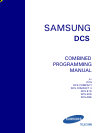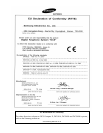
DCS INTRODUCTION
COMBINED PROGRAMMING MANUAL NOVEMBER 2001
1-1
Part 1. Introduction to Programming
This manual describes the MMC programming required for the following types of Sam-
sung DCS keyphone system:
• DCS
• DCS Compact (Compact I)
• DCS Compact II
• DCS-816
• DCS-408
• DCS-408i.
In this manual, these systems are referred to as “DCS,” “Compact I (CI),” “Compact II
(CII)," "816," "408" and “408i” respectively. Programming requirements for these system
types are generally the same, but occasionally there are differences. Users of 408 and
408i systems should also read Programming DCS-408 and 408i Systems in section 1.5.4
of this manual. Unless otherwise stated, references to “DCS” include Compact I sys-
tems.
The different system types are discussed fully in the separate Samsung General De-
scription manuals for each system, where these have been published.
Software Version Numbers
The software version numbers of the systems for which this programming manual is
relevant are: DCS and Compact II=V6.10 or later; 816=V1.09 or later; 408 and
408i=1.04 or later.
1.1 Using This Manual
• It is recommended that you read the whole of Part 1 of this manual which provides a
useful overview to MMC programming procedures.
• For a comprehensive list of available MMCs, see Part 2.
• For quick reference, Part 2 also provides a table listing the default settings for each
MMC and indicating which systems can use each MMC. A “Y” (“Yes”) in the appro-
priate column indicates that it can be used for that system.
• To quickly check allowed configuration settings for each type of system—number of
trunk group members, card port numbers, and so on—see section 2.3 System Con-
figuration: Quick Reference in Part 2.
• To begin programming, refer to the appropriate MMC(s) in Part 4. Check the se-
lected MMC header bar to make sure the program is available on your system, if
you haven’t already done so.
• Refer to Part 3, Special Applications, for further information on voice mail / auto at-
tendant integration, individual station paging, CLIP (Calling Line Identification Pres-
entation), toll restriction (call barring) and S
0 programming.


















